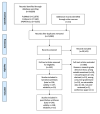Reliability and Validity of Commercially Available Wearable Devices for Measuring Steps, Energy Expenditure, and Heart Rate: Systematic Review
- PMID: 32897239
- PMCID: PMC7509623
- DOI: 10.2196/18694
Reliability and Validity of Commercially Available Wearable Devices for Measuring Steps, Energy Expenditure, and Heart Rate: Systematic Review
Abstract
Background: Consumer-wearable activity trackers are small electronic devices that record fitness and health-related measures.
Objective: The purpose of this systematic review was to examine the validity and reliability of commercial wearables in measuring step count, heart rate, and energy expenditure.
Methods: We identified devices to be included in the review. Database searches were conducted in PubMed, Embase, and SPORTDiscus, and only articles published in the English language up to May 2019 were considered. Studies were excluded if they did not identify the device used and if they did not examine the validity or reliability of the device. Studies involving the general population and all special populations were included. We operationalized validity as criterion validity (as compared with other measures) and construct validity (degree to which the device is measuring what it claims). Reliability measures focused on intradevice and interdevice reliability.
Results: We included 158 publications examining nine different commercial wearable device brands. Fitbit was by far the most studied brand. In laboratory-based settings, Fitbit, Apple Watch, and Samsung appeared to measure steps accurately. Heart rate measurement was more variable, with Apple Watch and Garmin being the most accurate and Fitbit tending toward underestimation. For energy expenditure, no brand was accurate. We also examined validity between devices within a specific brand.
Conclusions: Commercial wearable devices are accurate for measuring steps and heart rate in laboratory-based settings, but this varies by the manufacturer and device type. Devices are constantly being upgraded and redesigned to new models, suggesting the need for more current reviews and research.
Keywords: Apple Watch; Fitbit; Garmin; Polar; commercial wearable devices; energy expenditure; heart rate; step count; systematic review.
©Daniel Fuller, Emily Colwell, Jonathan Low, Kassia Orychock, Melissa Ann Tobin, Bo Simango, Richard Buote, Desiree Van Heerden, Hui Luan, Kimberley Cullen, Logan Slade, Nathan G A Taylor. Originally published in JMIR mHealth and uHealth (http://mhealth.jmir.org), 08.09.2020.
Conflict of interest statement
Conflicts of Interest: Author JL was employed by Garmin Inc. during the publication process but after completion of the paper. All other authors have no conflicts to declare.
Figures






References
-
- World Health Organization Global recommendations on physical activity for health. World Health Organization. [2020-08-17]. https://www.who.int/dietphysicalactivity/factsheet_recommendations/en/
-
- Conn VS, Hafdahl AR, Mehr DR. Interventions to increase physical activity among healthy adults: meta-analysis of outcomes. Am J Public Health. 2011 Apr;101(4):751–8. doi: 10.2105/AJPH.2010.194381. http://europepmc.org/abstract/MED/21330590 - DOI - PMC - PubMed
-
- Tudor-Locke C, Craig CL, Brown WJ, Clemes SA, De CK, Giles-Corti B, Hatano Y, Inoue S, Matsudo SM, Mutrie N, Oppert J, Rowe DA, Schmidt MD, Schofield GM, Spence JC, Teixeira PJ, Tully MA, Blair SN. How many steps/day are enough? For adults. Int J Behav Nutr Phys Act. 2011 Jul 28;8:79. doi: 10.1186/1479-5868-8-79. https://ijbnpa.biomedcentral.com/articles/10.1186/1479-5868-8-79 - DOI - DOI - PMC - PubMed
Publication types
MeSH terms
LinkOut - more resources
Full Text Sources
Other Literature Sources
Medical

